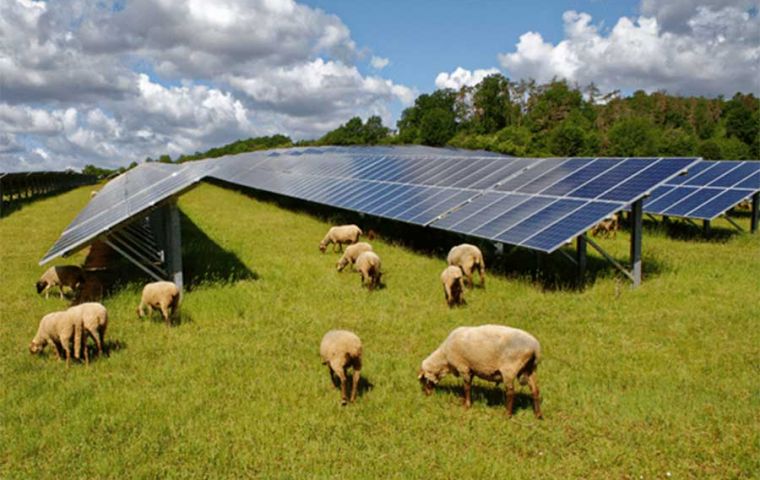MercoPress. South Atlantic News Agency
Better wool quality from grazing sheep among solar panels, shows experience in Australian green farm
 According to the head of the Allendale Merino Stud, in Wellington, the effect of solar panels in his sheep has meant wool quality production has “increased significantly.”
According to the head of the Allendale Merino Stud, in Wellington, the effect of solar panels in his sheep has meant wool quality production has “increased significantly.” Sheep grazing close to a solar farm among its panels seems to even improve the quality of wool, a new study has found. The study is based on the results of a second round of wool testing at the Wellington solar farm, in New South Wales, which has shared its site with 1,700 merino sheep for the past three years.
Apparently the decision to graze sheep at the solar farm came about when an employee of Lightsource bp, the owner of the Wellington project, complained to a local, sixth-generation wool farmer about the hassle and cost of mowing the solar farm six times a year.
In effect according to Tony Inder, who heads up the Allendale Merino Stud, the effect on his sheep has been a lot better than he thought it would be – he says the wool quality they are producing has “increased significantly.”
But Lightsource bp – which is now wholly owned by the oil and gas giant BP, after completing the acquisition of the remaining 50.03% interest – has used the opportunity to gather some formal data.
The study, conducted by EMM Consulting with support from Elders Rural Services, compares two groups of merino sheep – one group grazed in a regular paddock and the other at the Wellington solar farm.
The findings show grazing sheep among solar panels does no harm to wool production, even in the case of pre-existing high-quality standards. And it says that some parameters even indicate an improvement in wool quality, although conclusive benefits require further long-term measurement.
Lightsource bp says that while the study at the Wellington solar farm is ongoing, it is another indication that solar farms can exist side-by-side with sheep farming, for the benefit of both enterprises.
“These results are very encouraging and highlight the potential for solar farms to complement agricultural practices,” says Emilien Simonot, Lightsource bp’s head of agri-voltaics.
“By integrating sheep farming with solar energy production, we can achieve dual benefits of sustainable energy together with agricultural output”. By co-locating grazing with renewable energy, land can remain in agricultural use, offering farmers additional revenue while contributing to cleaner energy for the planet.
“Finding ways for agriculture and clean energy to work together is crucial for a more sustainable future,” says Brendan Clarke, interim head of environmental planning Australia and NZ at Lightsource bp.
“The promising results from this study indicate that we are on the right path, and working closely with farmers to grow our knowledge in this area is paramount.”
As for the sheep, Inder says they “just do really well” when grazing among the Wellington solar farm panels. I like to say that panel sheep are happy sheep.”

![“Working directly with President [Donald] Trump and Congress, we accomplished what no one else could,” Patel stressed](/data/cache/noticias/108417/130x80/fbi.jpg)


Top Comments
Disclaimer & comment rulesCommenting for this story is now closed.
If you have a Facebook account, become a fan and comment on our Facebook Page!